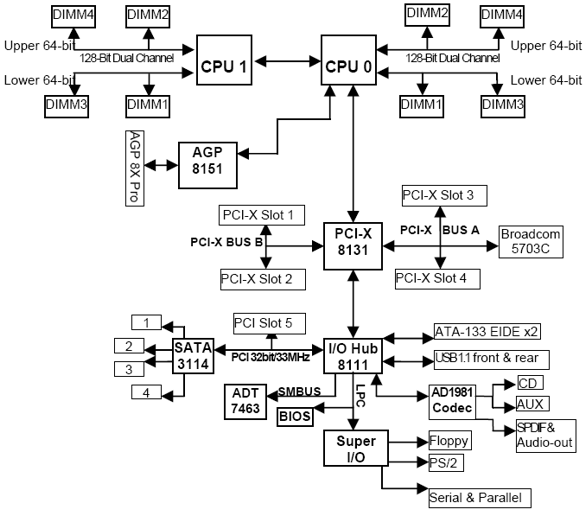AMD's Opteron 250 vs. Intel's Xeon 3.6 GHz in a Workstation Duel of the Elite
Chipset Platform: AMD 8100 + A8151 + A8131/8132 + A8111
Unlike Intel's Xeon, AMD cannot rely on at least two chipsets. The reference logic thus comes once again from AMD itself, although it would rather stay out of this business.
Because the chipset was launched together with the Opteron in April 2003, it can no longer be ranked at the top, technically speaking. But that's not so tragic now, because the only real downside is the lack of a PCI Express bridge for future graphics cards or other expansion cards. So AMD-based workstations will have to settle for AGP graphics cards for the time being. But considering the test results, this doesn't seem to be much of a problem. With regard to the data throughput rate, the PCI Express graphics still cannot make use of the speed advantage. The card manufacturers will eventually switch to PCI Express, with the result that new and correspondingly faster models will no longer necessarily be available in an AGP version.
But back to the main subject: the A8151 is needed as an AGP interface, while the A8131 represents the PCI-X bridge (two separate buses). Finally, A8111 is the I/O hub that gives access to all of the other interfaces like PCI, ATA/133, USB 2.0, sound and a low-pin-count interface for a Super I/O chip.
Because all the modules communicate via HyperTransport, they can in principle be combined in any way as long as HyperTransport tunneling is supported. Devices weighed down by I/O, like the A8151 for AGP and the A8131 for PCI-X, should however each be connected to the processor via its own HyperTransport channel.

Block diagram of the S2885 Thunder K8W from Tyan

The A8151 controller only holds the AGP interface.
Stay on the Cutting Edge
Join the experts who read Tom's Hardware for the inside track on enthusiast PC tech news — and have for over 25 years. We'll send breaking news and in-depth reviews of CPUs, GPUs, AI, maker hardware and more straight to your inbox.
Current page: Chipset Platform: AMD 8100 + A8151 + A8131/8132 + A8111
Prev Page 1, 2, 4... Or How About 8 CPUs? Continued Next Page Chipset Platform: AMD 8100 (A8151 + A8131/8132 + A8111), Continued-
bgd73 hey thanks for this. There is errors in the test, especially in memory speed of xeons, in fact, it is ridiculous. I am going for older 7525 chipset in CEB motherboard...these machines are just getting started. I be sure to go for HT. thanks.Reply
Most Popular

